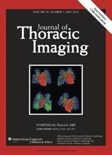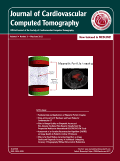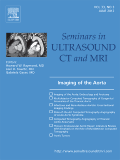
JOURNAL OF THORACIC IMAGING
Scope & Guideline
Elevating Standards in Pulmonary and Radiology Research
Introduction
Aims and Scopes
- Advanced Imaging Techniques:
Focuses on the application and development of advanced imaging modalities such as computed tomography (CT), magnetic resonance imaging (MRI), and positron emission tomography (PET), particularly in assessing thoracic diseases. - Clinical Outcomes and Diagnostic Performance:
Investigates the diagnostic performance of imaging techniques in relation to clinical outcomes, including lung cancer diagnosis, interstitial lung disease, and management of cardiovascular conditions. - Artificial Intelligence and Machine Learning:
Explores the integration of artificial intelligence (AI) and machine learning in thoracic imaging, emphasizing how these technologies enhance diagnostic accuracy and workflow efficiency. - Pediatric Thoracic Imaging:
Addresses the unique challenges and advancements in imaging pediatric populations, covering congenital heart diseases, lung disorders, and innovative imaging protocols. - Multidisciplinary Approaches:
Promotes a multidisciplinary perspective that includes collaboration between radiologists, pulmonologists, cardiologists, and oncologists in managing thoracic diseases and improving patient outcomes.
Trending and Emerging
- Quantitative Imaging and Biomarkers:
An increasing number of studies focus on quantitative imaging techniques and biomarkers that enhance the understanding of disease progression and treatment response, particularly in interstitial lung disease and lung cancer. - Integration of AI in Imaging:
There is a significant uptick in research exploring the application of AI and machine learning for improving diagnostic accuracy, automating image analysis, and enhancing workflow efficiency in thoracic imaging. - Impact of COVID-19 on Thoracic Imaging:
Research addressing the implications of COVID-19 on thoracic imaging practices, including diagnostic challenges and imaging features specific to the disease, has become a prominent area of study. - Personalized Medicine and Imaging:
Emerging studies are increasingly focusing on personalized medicine approaches, utilizing imaging to tailor treatment strategies based on individual patient characteristics and disease profiles. - Comparative Effectiveness Research:
The journal is witnessing a growing trend in comparative effectiveness studies that evaluate different imaging modalities and protocols in terms of diagnostic accuracy, cost-effectiveness, and patient outcomes.
Declining or Waning
- Traditional Radiographic Techniques:
There has been a noticeable decrease in studies focusing solely on traditional radiographic techniques, as more advanced imaging modalities like CT and MRI are preferred for thoracic assessments. - Basic Descriptive Studies:
Research that primarily describes imaging findings without advanced analytical techniques or clinical correlations is becoming less frequent, as the field moves towards more sophisticated methodologies. - Single-Center Studies:
The prevalence of single-center studies is declining, with a trend towards larger, multicenter collaborations that provide more generalizable results and insights. - Less Emphasis on Non-Diagnostic Imaging:
Topics related to non-diagnostic imaging practices or those lacking significant clinical implications are being phased out in favor of research that directly impacts patient care and outcomes.
Similar Journals

Current Cardiovascular Imaging Reports
Transforming Diagnostics through Cutting-edge Imaging TechniquesCurrent Cardiovascular Imaging Reports, published by SPRINGER, is a notable academic journal within the field of cardiovascular imaging. With its ISSN 1941-9066 and E-ISSN 1941-9074, this journal has been a critical resource since its inception in 2008, aiming to disseminate high-quality research and reviews in the realm of cardiovascular diagnostics and imaging technologies. Though currently categorized within the Q3 and Q4 quartiles for various fields such as Applied Microbiology and Biotechnology, Histology, and Cell Biology, its impact and relevance are growing steadily. Researchers and practitioners can benefit from the insights presented in this journal, especially as it covers advancements and practical applications in cardiovascular imaging techniques crucial for enhancing patient care. Given its ongoing commitment to open access, although not currently available, readers can engage with significant research findings that may inform future studies and applications in cardiology. With plans to converge towards 2024, this journal is poised to facilitate the exchange of knowledge and foster innovation within its dynamic field.

PET Clinics
Transforming Medical Imaging with Cutting-Edge Techniques.PET Clinics, published by Elsevier Inc, is a premier academic journal focusing on the advancements and applications of Positron Emission Tomography (PET) in various medical fields. With its ISSN 1556-8598 and E-ISSN 1559-7814, the journal has established a strong reputation in the scientific community, reflected in its impressive Q1 quartile rankings in Medicine (miscellaneous), Radiation, and Radiology, Nuclear Medicine, and Imaging for 2023. The journal operates within a well-defined scope that bridges innovative research and practical clinical applications, targeting professionals, researchers, and students keen on the intersection of nuclear medicine and imaging technologies. Although not an open-access journal, PET Clinics ensures accessibility through institutional subscriptions, making valuable insights available to the academic community. With an emphasis on enhancing patient care and treatment outcomes through cutting-edge imaging techniques, this journal serves as an essential resource for those seeking to expand their knowledge and expertise in the rapidly evolving field of PET.

Oral Radiology
Advancing oral health through innovative imaging research.Oral Radiology is a prestigious academic journal published by Springer, dedicated to advancing the field of dentistry and radiology through high-quality research and innovative findings. With a focus on oral imaging, it has established itself as a vital resource for researchers, clinicians, and students alike, striving to bridge the gap between cutting-edge imaging technologies and practical applications in oral health. Covering a diverse range of topics from 1985 to 2024, this journal not only holds a commendable Q2 ranking in both the Dentistry (miscellaneous) and Radiology, Nuclear Medicine and Imaging categories but also ranks impressively within the Scopus metrics, placing it among the top-tier publications in its field. While not an open-access journal, Oral Radiology remains a crucial platform for disseminating significant advances, influencing both academic research and clinical practices. Its rigorous peer-review process ensures that only the highest quality articles are published, making it an essential read for those seeking to stay at the forefront of oral radiological science.

MAGNETIC RESONANCE MATERIALS IN PHYSICS BIOLOGY AND MEDICINE
Elevating Research in Magnetic Resonance TechnologiesMAGNETIC RESONANCE MATERIALS IN PHYSICS BIOLOGY AND MEDICINE, published by SPRINGER, is a premier academic journal dedicated to advancing the fields of biophysics, radiology, and medical imaging. With a strong presence in Germany and an international readership, this journal has established itself as a vital resource for researchers and professionals engaged in the interdisciplinary study of magnetic resonance applications. Featuring a commendable 2023 impact factor and categorized in Q2 quartiles across several domains—including Biophysics and Radiological Technologies—this journal provides a platform for innovative research and practical implementations in the field. Although it does not follow an Open Access model, it offers extensive archives dating back to 1984, affirming its long-standing commitment to scholarly excellence. The journal not only ranks impressively within Scopus metrics, but it also promotes ongoing discourse that bridges gaps between physics, biology, and medicine, making it an essential read for professionals and students aiming to stay informed about cutting-edge developments.

Journal of Cardiovascular Computed Tomography
Transforming cardiovascular medicine with cutting-edge research.The Journal of Cardiovascular Computed Tomography, published by Elsevier Science Inc, is a premier international journal dedicated to the field of cardiovascular imaging and technology. With a strong impact factor, it serves as a pivotal platform for disseminating cutting-edge research and advancements from 2007 to 2024, specifically within the realms of cardiology and radiology. The journal holds a distinguished Q1 ranking in both Cardiology and Cardiovascular Medicine and Radiology, Nuclear Medicine and Imaging, reflecting its influential role in shaping clinical and academic discourse in these fields. Notably, the journal boasts impressive Scopus rankings, placing it in the top decile of its categories, highlighting its high-quality publications and significant contribution to the scientific community. Although it does not operate under an open access model, it ensures robust accessibility for researchers, professionals, and students eager to stay informed about the latest innovations and studies in cardiovascular computed tomography. The Journal of Cardiovascular Computed Tomography is essential for anyone involved in cardiovascular research, offering valuable insights and fostering collaborations across disciplines.

Forensic Imaging
Fostering breakthroughs in forensic evidence analysis and application.Forensic Imaging is a premier international journal dedicated to advancing the field of forensic science through the analysis and implementation of imaging techniques. Published by ELSEVIER, this open access journal provides a platform for researchers, professionals, and students to disseminate innovative studies that bridge the disciplines of Pathology, Forensic Medicine, and Radiology. Since its inception in 2020, it has gained recognition and holds a respectable Q3 ranking in its categories for both Pathology and Forensic Medicine and Radiology, Nuclear Medicine and Imaging, reflecting its commitment to high-quality, impactful research. The journal's practical focus on imaging methodologies offers valuable insights into forensic investigations and enhances professional practices, making it an essential read for those involved in forensic research and application. Available in both print and online formats, Forensic Imaging serves as a vital resource for fostering breakthroughs in the analysis of forensic evidence.

SEMINARS IN ULTRASOUND CT AND MRI
Exploring the Depths of Radiological ScienceSEMINARS IN ULTRASOUND CT AND MRI is a prestigious academic journal dedicated to advancing the fields of radiology, nuclear medicine, and imaging. Published by W B SAUNDERS CO-ELSEVIER INC, this journal has been a cornerstone of scholarly communication since 1984, providing a platform for high-quality research and review articles that enhance the understanding of diagnostic imaging techniques. With a current impact factor reflected in its Q3 quartile ranking among 333 journals in its category, it remains a valuable resource for researchers and clinicians alike. The journal's focus includes but is not limited to innovations in ultrasound, computed tomography, and magnetic resonance imaging, making it essential for professionals looking to stay at the forefront of imaging science. While it operates under a subscription model, its extensive archive of influential articles ensures ongoing access to critical knowledge and developments in the field. With a commitment to quality and relevance, SEMINARS IN ULTRASOUND CT AND MRI continues to contribute significantly to the evolving landscape of medical imaging.

DENTOMAXILLOFACIAL RADIOLOGY
Transforming Patient Care through Radiological InnovationDentomaxillofacial Radiology, published by the British Institute of Radiology, serves as a premier journal in the realm of radiology, focusing specifically on imaging techniques and methodologies that are essential for the diagnosis and treatment in the dental and maxillofacial regions. Since its inception in 1972, the journal has maintained a rigorous standard for publishing impactful research, currently boasting an impressive impact factor that underscores its relevance and authority in the field. With categorization in Q1 for both Dentistry (Miscellaneous) and Otorhinolaryngology, as well as Q2 for Medicine (Miscellaneous), this journal supports professionals and students alike through the dissemination of cutting-edge research. Although it does not currently operate as an open-access platform, it is accessible for a wide audience eager to engage with the latest advancements in radiology, nuclear medicine, and imaging. By bridging the gap between clinical practice and innovative research, Dentomaxillofacial Radiology continues to be an invaluable resource for academics and practitioners seeking to enhance their expertise and improve patient outcomes in a rapidly evolving field.

Chinese Journal of Academic Radiology
Transforming Radiology: Where Knowledge Meets InnovationChinese Journal of Academic Radiology is a leading publication in the field of Radiology, Nuclear Medicine, and Imaging, published by SpringerNature. With an ISSN of 2520-8985 and E-ISSN 2520-8993, the journal aims to bridge the gap between academic research and practical application in radiological sciences. Recognized for its contributions to the advancement of imaging technology and patient care, it currently holds a Q3 quartile ranking for 2023. The journal has a commitment to sharing innovative research findings that address pressing challenges in the field, thereby fostering collaboration and knowledge exchange among researchers, professionals, and students. Although it does not currently offer open access options, the journal's comprehensive reviews and high-quality research articles present a significant resource for those seeking to deepen their understanding of radiological practices and innovations. The Chinese Journal of Academic Radiology continues to play a vital role in shaping the future of radiological science through rigorous scholarship and global discourse.

Turkish Thoracic Journal
Exploring the forefront of thoracic research and clinical practice.Turkish Thoracic Journal, published by AVES, is a prominent open-access platform dedicated to advancing the field of pulmonary and respiratory medicine. Since its establishment, the journal has aimed to disseminate significant research findings, clinical studies, and reviews that contribute to an improved understanding of respiratory health challenges, with a particular focus on the Turkish context and regional issues. With an E-ISSN of 2149-2530 and transitioning to open access in 2022, the journal enhances visibility and accessibility, inviting a global audience of researchers, clinicians, and students to engage with the latest scientific work. The Turkish Thoracic Journal has been indexed in major databases, although it faced a coverage discontinuation in Scopus between 2016 and 2022. Currently positioned within the 23rd percentile among its peers in the field, it invites submissions that explore innovative approaches to thoracic health, enriching the discourse in a vital area of medicine.